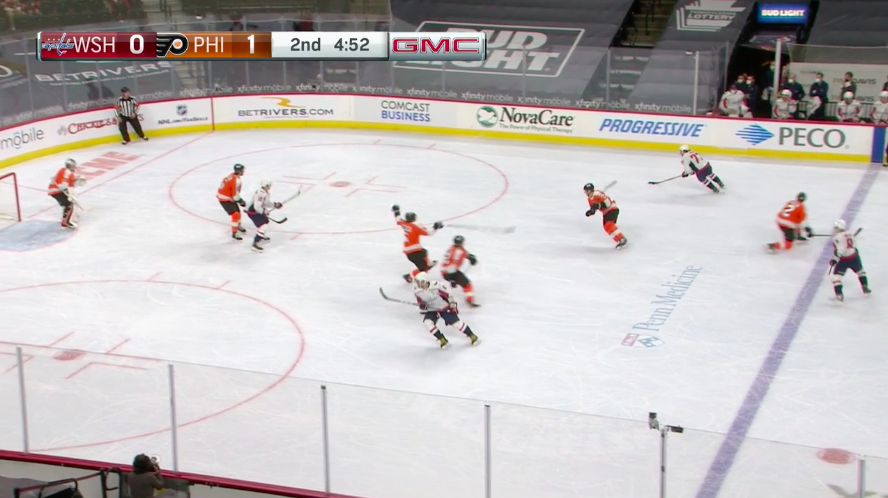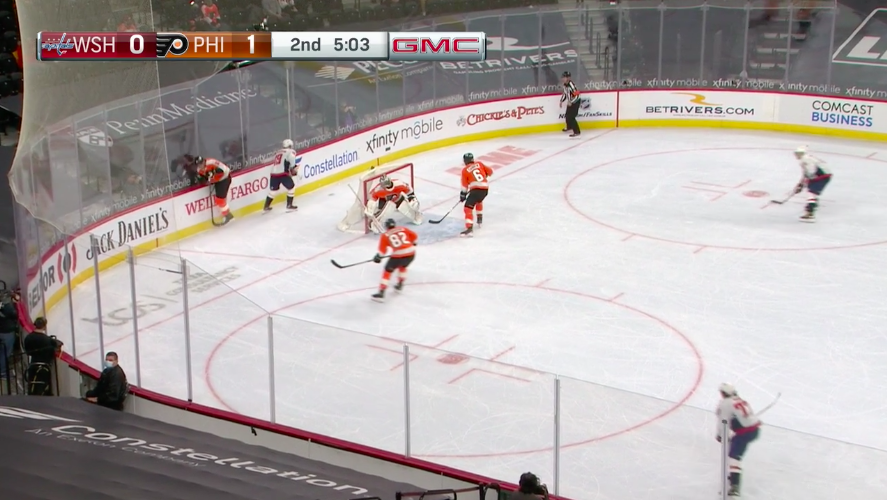Flyers Film
Flyers Film: Missed assignments result in two momentum-changing goals

The Philadelphia Flyers just didn’t have it on Sunday night against the Washington Capitals. In their final game of a tough stretch of four games in six days, they came out hot but then fell flat. The Flyers defense broke down a few times and it cost them.
GIF Rewind: Flyers’ energetic start fades in first game in front of fans
The frustrating thing about the loss is that the Flyers could’ve easily won the game. They were outplayed, particularly in the second period, but they weren’t completely silenced. The Flyers had a lot of offensive-zone time in the first period that only resulted in a goal off a rush, and they missed a few prime chances in the second period as well.
But those things are going to happen. Teams aren’t going to score on all of their chances and offensive-zone time doesn’t always lead to goals. It didn’t for the Flyers on Sunday night.
Flyers fans get loud in first game back at Wells Fargo Center
The problem on Sunday night was with the defensive coverage on the Capitals’ three goals. Carter Hart played well enough to win, but his team hung him out to dry on a few occasions in the loss. He stopped all the shots that he should’ve, and didn’t really have much of a chance on at least the first two goals.
Those first two goals are what completely changed the momentum of the game. The Capitals were the better team in the second period – there’s no doubt about that – but it looked like the Flyers could tread water to get to intermission. They had survived the first half of the period and had some scoring chances of their own that they could’ve extended their lead on, but then the Capitals struck.
Less than two minutes after Travis Konecny missed wide on a tip-in and Travis Sanheim hit the crossbar, the puck was in the back of the Flyers net. Unfortunately, it was due to something we’ve seen all too frequently as of late: defensive breakdowns.
Alex Ovechkin had an open net to shoot at after a nice cross-ice pass by T.J. Oshie. Oshie actually had two Capitals on the backdoor to pass to after Zdeno Chara pinched in as well.
It started with a simple dump-in by the Capitals. As you can see in the screenshot below, Nicklas Backstrom is in position to get to the puck first as it rims around the boards.

Myers attempted to stick lift Backstrom, but he pushed the puck further along the wall. With Connor Bunnaman as a third man back, Sanheim plays too cautiously as he elects to stay in front of the net rather than stay to the outside a bit more.

If Myers successfully tied up Backstrom, Bunnaman would be there as the second man in to try to win the battle. If Backstrom was able to move the puck along, which he did, Myers would have time to get back in front while Bunnaman holds the slot.

With Sanheim down low, Alex Ovechkin is able to beat Oskar Lindblom to the puck and send it back around. Even with three Flyers below the dots against just Backstrom, their positioning compared to the puck allows Washington to keep control.
Ovechkin whipped the puck back around the boards, where Nicolas Aube-Kubel failed to chop the puck passed Zdeno Chara. The big man knocked it down right to Oshie. He took the puck around the zone and the Flyers got all out of sorts.
Let’s watch it unfold and then break it down.
Sanheim moved from his post on the left side of the ice all the way to the high slot to cover Ovechkin. He then trips and makes a pick on Aube-Kubel, taking him out of the play. Aube-Kubel also should have recognized that Chara had snuck behind him, and then Ovechkin snuck behind him after Sanheim fell.
Oshie’s stickhandling allowed him to maintain control of the puck and take advantage of Sanheim falling. Ovechkin and Chara were both wide open on the backdoor.
One final screenshot (for this goal) sums it up.

Sanheim’s falling, Aube-Kubel is slow to cover Ovechkin and eventually can’t because of Sanheim falling, Bunnaman almost at the blue line after tripping over Oshie, and Ovechkin going in for the kill.
Flyers defense at its finest.
That tied the game at one with 4:49 left in the second period. In a period that the Capitals dominated, a 1-1 tie heading into intermission would’ve been fine. And it looked like it was going to be fine until the final 30 seconds of the period.
Ivan Provorov blocked a shot, got to the loose puck, and cleared the zone. James van Riemsdyk raced down the ice in an attempt to get to the puck and negate an icing if the puck reached the goal line.
Unfortunately, the linesman was racing right along JVR and put his hand up at the last possible moment to call icing on the play. JVR wasn’t pleased.
“Big call with 22 seconds remaining,” Jim Jackson said. It certainly was, Jim.
The Capitals won the faceoff and seven seconds later had a 2-1 lead.
Joel Farabee went out to the point to pressure Dmitry Orlov off the faceoff. He then stays up too high and is late to realize that Orlov has snuck behind him for another backdoor goal.
The defensemen had their guys in front, Sean Couturier was pressuring the puck, and van Riemsdyk was out up top. If Farabee had stayed with Orlov, there wouldn’t be such an open passing option for John Carlson, who would likely end up just firing a shot through traffic. But Farabee lost his assignment for a split second and it cost him.
That was a back-breaking goal. The first goal was more understandable. It was coming all period long. But that goal, given the questionable icing call and the timing, completely deflated the Flyers.
| 2021 Season | Leading after two | Tied after two |
Trailing after two
|
| Capitals | 9-1-0 | 3-1-4 | |
| Flyers | 4-2-2 | 1-4-0 |
Records do not include Sunday night’s game
The Flyers may have still lost, who knows. The Capitals hadn’t played since Friday and the Flyers played on Saturday in Pittsburgh. The third period could’ve been more of the same with the Capitals dominating. But we’ll never know.
Oskar Lindblom receives huge ovation in first game back in front of Flyers fans
It’s been getting increasingly frustrating seeing the Flyers have defensive breakdowns result in goals in almost every game. When a team makes a good play and scores like that, you can just tip your hat and try to get it back. When it’s a pattern of defensive mistakes, missed assignments, and poor positioning, it gets to be worrisome.




















